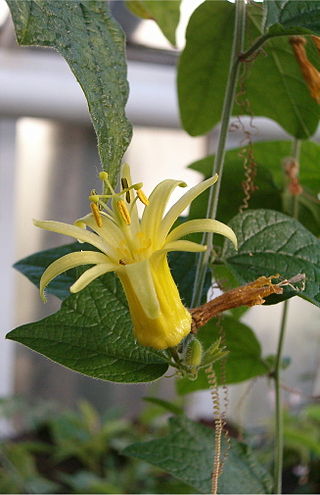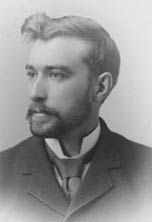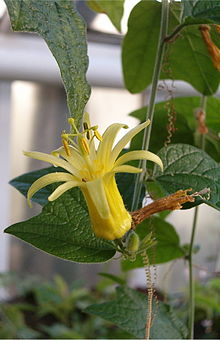
William James Beal was an American botanist. He was a pioneer in the development of hybrid corn and the founder of the W. J. Beal Botanical Garden.
Passiflora trochlearis is a species of plant in the family Passifloraceae. It is endemic to the coastal lowlands of Ecuador. It is named after its purple trochlea which stands out from its light green androgynophore.
Julian Alfred Steyermark was a Venezuelan American botanist. His focus was on New World vegetation, and he specialized in the family Rubiaceae.

Passiflora citrina is a species of passion flower (Passiflora) native to Central America. It is also grown as an ornamental plant.

Passiflora antioquiensis, the red banana passionfruit, is a species in the family Passifloraceae. It is native to Colombia and is named for the Antioquia Department in Colombia where the type specimen was collected. It was originally described by Gustav Karl Wilhelm Hermann Karsten in 1859. It has gained the Royal Horticultural Society's Award of Garden Merit. With Passiflora tripartita var. mollissima it was hybridised in the Veitch Nurseries in Exeter, England in the 1870s to yield Passiflora × exoniensis, which has also gained the Award of Garden Merit.
Passiflora viridescens is a plant species native to Perú and Ecuador.
Roy Emile Gereau is an American botanist and explorer.

Sandra Diane Knapp is an American-born botanist. She is a merit researcher of the Plants Division of the Natural History Museum, London and from 2018 was the president of the Linnean Society of London. While working at the Natural History Museum, London she has overseen the Flora Mesoamericana inventory of Central American plants. She has published several books on botanical subjects as well as a significant number of scientific articles. In 2016 she was awarded the Linnean Medal. In 2022 she was elected as a Fellow of the Royal Society. In 2023 she was appointed an Officer of the Order of the British Empire (OBE) and was awarded the Engler Medal in Gold by the International Association for Plant Taxonomy.
George Hill Mathewson Lawrence was an American botanist, writer and professor of botany who helped establish the 'Liberty Hyde Bailey Hortorium', the Hunt Botanical Library and the Huntia journal. He was also an avid book collector, including books on the history of Rhode Island, historic books and botanical art.
Mildred Esther Mathias was an American botanist and professor.
Passiflora quetzal is a species of flowering plant native to Mexico and Guatemala described in 2004. It is named after the quetzal, which inhabits the area.
Brian Morey Boom is an American botanist who specializes in the flora of the Guianas and the Caribbean, the family Rubiaceae, ethnobotany, and economic botany.
John Cameron Semple is a botanist, cytotaxonomist, professor emeritus, and adjunct professor at the University of Waterloo in Ontario, Canada. He was born in Boston and earned a degree of Bachelor of Science in 1969 from Tufts University, followed in 1971 and 1972 by Master of Arts and Doctor of Philosophy degrees from Washington University in St. Louis. Semple is known for his work with members of the tribe Astereae, particularly goldenrods, American asters, and goldenasters, and he maintains the University of Waterloo Astereae Lab website. Semple's wife is Brenda, and in 2013, he named a newly discovered goldenrod species Solidago brendiae in honor of her.
Thomas Bernard Croat is an American botanist and plant collector, noteworthy as one of botanical history's "most prolific plant collectors". He has collected and described numerous species of plants, particularly in the family Araceae, in his career at the Missouri Botanical Garden.

Charles Bixler Heiser Jr. (1920–2010) was a professor of botany, known as a leading expert on the sunflower genus Helianthus. He is also noteworthy as the author of a "series of popular books that did much to promote botany to the general public."
Emanuel David "Rudy" Rudolph was a botanist, lichenologist, and historian of botany. He was "the first botanist to conduct diverse experiments on the total biology of lichens in both polar regions".

Dr. Daniel Trembly MacDougal was an American botanist and writer. He is known for his work on desert ecology and as the earliest botanist to research Chlorophyll. He was the inventor of the MacDougal dendrograph, used to record changes in the volumes of tree trunks. He was a pioneer in studying the idea of Mutation Theory for controlling evolution. He helped to establish two botanical laboratories, the Desert Laboratory in Tucson, Arizona, and the Coastal Laboratory in Carmel-by-the-Sea, California.
Passiflora xiikzodz, the xiikzodz, is a species of flowering plant in the passion flower/passion fruit family Passifloraceae, native to southeastern Mexico, Belize, and Guatemala. The specific epithet is derived from the Mayan vernacular name for the species, and means "bat-wing". It is closely related to Passiflora itzensis but attempts to cross-pollinate the two species do not result in any offspring.

Lawrence E. Gilbert is an American biologist, known for his discovery of Gilbertian mimicry.







